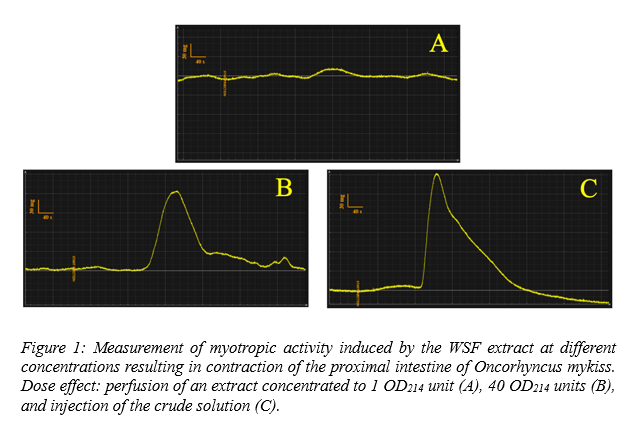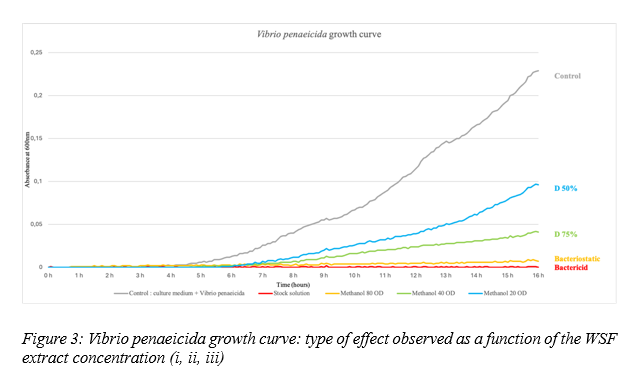IN SILICO AND IN VITRO INVESTIGATIONS OF BLACK SOLDIER FLY Hermetia illucens LARVA MEAL BIOACTIVITY: MYOTROPIC POTENTIAL ON THE INTESTINAL TRACT OF RAINBOW TROUT Onchorhynchus mykiss AND ANTIBACTERIAL PROPERTIES AGAINST VARIOUS PATHOGENS
Introduction
The industrialization of the aquaculture sector has been accompanied by a strong demand for raw materials to meet growing feed requirements. Fishmeal remains the main source of animal protein despite its high price and harmful impact on marine ecosystems. In this context, a substantial part of the fishmeal in aquaculture feeds has already been substituted by plant-based resources such as soy-based proteins. However, these alternatives also come with their sustainability issues and high environmental impact. Insect-based protein has more recently been proposed as a robust and more sustainable option, with a nutritional profile well adapted to aquatic species . The protein-rich larvae of the black soldier fly (Hermetia illucens) (BSF) are currently farmed industrially to produce meal. This study aims to assess the bioactive potential of the soluble fraction of insect meal – water soluble fraction (WSF) – potentially correlated with health and well-being claims.
Materials and methods
Total RNA from Hermetia illucens larvae was extracted to construct a transcriptome. Sequencing was performed on an Ilumina NovaSeq 6000 sequencer using a cDNA library. Sequence cleaning and transcriptome assembly and annotation were carried out by the ABiMS platform (Roscoff biological station - CNRS). In silico analysis of the transcriptome was carried out using PepTraq software to identify the myotropic neuropeptides and antibacterial peptides expressed by BSF larvae. At the same time, peptides extracted from water soluble fraction (WSF ) were used for functional tests. Myotropic activity tests were carried out on the proximal part of the intestine of rainbow trout (Oncorhynchus mykiss) using an electrophysiology system to measure intestinal contraction. Antibacterial activity tests were carried out through the growth of a wide range of pathogens of aquatic organisms – Aeromonas salmonicida , Flavobacterium psychrophilum , Yersinia ruckeiri , Lactococcus garvieae , Vibrio parahaemolyticus, Vibrio alginolyticus , Vibrio splendidus , Vibrio anguillarum , Vibrio vulnificus, Vibrio harveyi , Vibrio fisheri, Vibrio penaeicida – was assessed . Growth inhibition percentages were determined in triplicate by liquid growth inhibition tests using a Bioscreen system.
Results
The Hermetia illucens larva transcriptome included 355,085 transcripts, 69,323 (19.5%) of which possessed a signal peptide. Twenty-six protein precursors corresponding to 22 families of neuropeptides with potential myotropic activity were identified . Seventy-two protein precursors of antibacterials grouped into 4 families were also identified: defensins (30 ), cecropins (27), attacins (3) and diptericins (12).
Functional tests of myotropic activity revealed that the amplitude and tone of contractions were proportional to the WSF concentration (Figure 1), highlighting a dose effect and a dose-dependent response.
Antibacterial activity m easurements revealed three types of effect on the growth kinetics of the pathogens tested in the presence of crude WSF extracts (Figure 2): i ) reduced growth, ii) a bacteriostatic effect, and iii) a bactericidal effect. Growth inhibition was observed on Lactococcus gaerviae and Vibrio anguillarum . A bacteriostatic effect was observed on Flavobacterium psychrophilum , Vibrio fisheri, and Vibrio splendidus. Finally, a bactericidal effect was observed on Vibrio penaeicida whatever the crude extract extraction method, which turned into a bacteriostatic effect from the dilution corresponding to 80 OD214 units.
Conclusion
This initial in vitro approach confirmed the bioactive potential of BSF meal . Its myotropic effects could lead to improved feed digestibility, and its antibacterial properties could significantly reduce the use of antibiotics at a time when antibiotic resistance is a growing concern.



